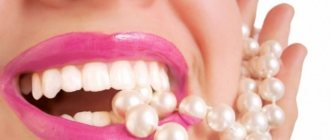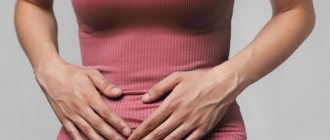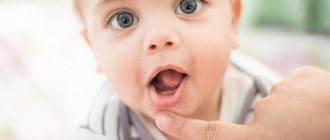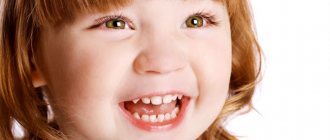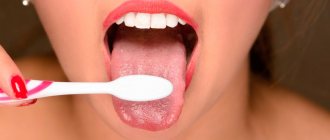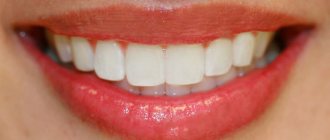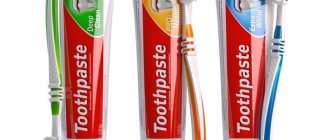Many parents believe that oral hygiene begins with caring for the first, baby teeth. In fact, even earlier - by cleaning the tongue and gums. Moreover, according to the New York State Department of Health, you need to take care of your baby's oral cavity from birth.
Why do you need to clean your baby’s tongue?
A clean environment in the mouth promotes the health of the first, baby teeth.
Here are a few more reasons why you should brush your baby’s tongue:
- Breast milk, like formula, contains sugar. This is why it is important to clean your baby's tongue and gums after feeding.
- Oral thrush, or oral thrush, is a fungal infection that appears as white patches on the tongue, cheek, roof of the mouth, and gums. Regular cleaning of your mouth helps maintain proper hygiene and helps you avoid such health problems.
- Maintaining oral hygiene from an early age accustoms the child to a certain routine and order, and in the future there will be no problems with a toothbrush or tongue scraper.
How to clean a baby's tongue?
The baby may initially suck or bite their fingers, thinking they are food. Give your baby time to adapt to new sensations.
- Wash your hands thoroughly with soap and water.
- Dip a clean sponge or gauze pad into warm water and wrap it around your index finger.
- Gently open your baby's mouth and insert your finger inside.
- Move your finger in a circle on top of your tongue, being careful not to slide down to your throat.
- If the baby has already developed baby teeth, they should also be cleaned with gauze, as well as the gums and the inside of the cheek.
- When brushing your tongue, be sure to check your mouth for any stubborn, thick white coating. This could be oral candidiasis.
It is recommended to clean your child's tongue and mouth at least once a day.
How to clean a baby's gums?
- Distract your child during the procedure.
- Hold your baby in your arms to coordinate his actions.
- Wait until your child is in a good mood before starting the procedure.
- Set aside a specific time during the day for the procedure. This helps create a sense of routine.
The following precautions will help avoid any injury during the procedure:
- Only use a clean sponge to avoid the risk of any infection.
- Keep nails short and clean to avoid any injury to baby's delicate tissues.
- Do not forcefully clean your child's tongue.
References:
- Infant and Children's Oral Health; The New York State Department of Health
- Breastfeeding: 6 Things Nursing Moms Should Know About Dental Health; American Dental Association
- Thrush—Child; Winchester Hospital
On the Vikids platform you can:
Newborn nose care
Breasts breathe through their noses during feeding, so if congestion or an accumulation of dry crusts occurs, it not only becomes difficult for the child to breathe, but also to eat. New mothers need to pay special attention to the condition of the baby’s nose after regurgitation, because some of the milk can enter the nasopharynx, complicate breathing and contribute to the development of bacteria . For the baby’s comfort, hygiene procedures should be carried out at least once a day. It is allowed to use special solutions to clean the nasal passages.
- Saline solution. You can buy it at a pharmacy for a small price, and its quantity will last for a long time. The saline solution contains water and sodium chloride.
- Saline solution . Budget option for saline solution. One teaspoon of salt is required for one liter of warm purified water. The salt must be free of impurities and completely dissolved.
- Various types of seawater-based sprays . There are a large number of options for sprays and drops in pharmacies: aquamaris, aqualor, morenasal.
To clean your baby's nose, you need to:
- put the child in a horizontal position or hold him in his arms and tilt his head slightly back;
- drop two drops of one of the above solutions into each nasal passage and wait at least a minute. The mucous membrane will moisten and the crusts will soften;
- Take a pre-prepared cotton wool (a twisted cotton ball), insert it into the spout no more than 1.5 cm and gently twist. Make a separate turund for each nasal passage.
Caring for a newborn's nose should include yourself and monitoring the humidity in the room. If the air is very dry, then crusts can often form in the nose. To avoid this, after cleaning, it is advisable to lubricate the spout with a couple of drops of peach oil applied to the turunda . In situations where a child has severe nasal congestion, special nasal aspirators , which delicately remove excess mucus.
Before using the aspirator, all parts of the device must be doused with boiling water . Before inserting the nozzle into your baby's nostril, test the suction strength on your hand. This will help avoid strong pressure on the mucous membrane. The nozzle should not be inserted vertically, but at an angle, pointing the tip towards the back wall of the nasopharynx.
Advice! Pull out the snot slowly, inhaling calmly and trying to get into the baby’s breathing rhythm: your inhalation together with his exhalation.
In order to prevent your child from having a stuffy nose and crusts from appearing, you need to follow the basic rules:
- monitor the level of humidity in the room, too dry and hot air contributes to crusts, and very humid air leads to a physiological runny nose;
- carry out wet cleaning to remove dust;
- Walk more often and ventilate the room.
Child's age: 3-4 months.
As a rule, the first teeth begin to appear in a newborn at six months of age. Is it necessary to maintain a child’s oral hygiene one and a half to two months before teething? Not all experts have the same opinion on this matter.
Some pediatric dentists believe that there is no need for any special hygiene procedures before teeth erupt.
Another group of pediatric dentists recommends starting gentle massage and cleaning of gums in children at three months of age. According to them, removing plaque, which inevitably forms on the gums as a result of feeding, will prevent the proliferation of pathogens on the mucous membrane, which will reduce the risk of caries in the future. It is also important that the child immediately gets used to hygienic procedures inside the oral cavity, and will not show resistance or be capricious when in the future it is necessary to carry out a full brushing of the teeth.
Caring for a newborn's mouth
It would seem, why care for a baby’s mouth if he doesn’t have teeth yet and doesn’t eat anything except mother’s milk. There is no need to wipe your newborn's mouth every day, but you should monitor the condition of the oral cavity daily.
The fact is that during regurgitation and feeding milk, residues can accumulate on the baby’s tongue and inner cheeks, which can cause a white coating - a fungus of the genus Candida . This fungus can create discomfort in the baby during feeding and even cause intestinal dysbiosis. If plaque appears, you should consult your pediatrician.
Important! To prevent oral thrush in a newborn, you need to carry out basic hygiene procedures: wash the breast before feeding, disinfect all toys and objects that the child puts in his mouth.
If a white coating appears, the baby should undergo cleansing procedures at least three times a day . To do this, you can use special preparations recommended by your doctor or a soda solution (1 teaspoon of soda per 250 ml of warm boiled water).
Wrap your little finger in two layers of bandage and soak it in the solution of your choice, then, without applying too much pressure, wipe your baby's mouth. The course of treatment is usually 5-10 days , depending on the strength of the plaque. All daily hygiene procedures take a little time, but allow the child to explore the world around him with a feeling of comfort.
Proper care of a newborn’s oral cavity, skin and nasal mucous membranes is an excellent prevention of many ailments. You can watch the following video to learn how to properly clean your nose and what equipment is needed for this:
Umbilical wound.
During the first week (on the 3-7th day of the baby’s life), the umbilical cord falls off, and an umbilical wound forms in its place. In international practice, its treatment is not recommended, but in current real practice it is recommended to treat it with antiseptic solutions once a day, after bathing. After bathing your baby, dry the umbilical wound with a sterile cotton swab. A 1% solution of brilliant green is often used to treat the umbilical wound. However, there is one drawback: the “green” stains the skin too brightly, which is why you may not notice the redness - a symptom of inflammation. This problem will not arise with transparent antiseptics. If there is small fresh or dried discharge from the umbilical wound (crust), apply a sterile cotton swab moistened with a 3% hydrogen peroxide solution for a couple of minutes, and then dry the wound with a sterile cotton swab.
The umbilical cord remnant, as well as the umbilical wound, cannot be covered with bandages, etc., and the diaper should not touch it. Therefore, in the first weeks of life, it is better to use special diapers for newborns, which have a recess for the navel.
Healing of the umbilical wound usually occurs by 2 weeks of a newborn baby’s life. If the umbilical wound does not heal for a long time, redness of the skin around the navel, bleeding or discharge (except blood discharge) appears, parents should immediately consult a doctor.
Some infants have an umbilical hernia (a protrusion in the navel area when crying). As a rule, there is nothing urgent in this situation, but you should consult a pediatric surgeon. Under no circumstances should you place objects (for example, a coin) on your navel and/or stick a band-aid on them!
Child's age: 6-9 months.
During this period, teeth begin to actively cut. And what is also important is that at this age the child usually begins to receive complementary foods, which means the risk of bacterial growth inside the oral cavity increases. If dentists have different opinions regarding the previous stage of development, here they are much more definite - from the moment the first tooth erupts, active hygienic measures will be needed. During this period, the mucous membrane is very vulnerable, and the local immunity of the oral cavity decreases. With careless hygiene, the risk of developing gingivitis and stomatitis increases significantly.
Even if a tooth has barely appeared above the surface of the gum, at one edge or at one corner, it already needs to be cleaned regularly. It is also necessary to clean the gums from fragments of the complementary foods the child receives, as a result of which plaque forms.
Professional oral hygiene in children
Professional hygiene is usually understood as a set of procedures, the purpose of which is to improve the health of the tissues and organs of the oral cavity and prevent the occurrence of dental ailments. This includes removing soft and hard plaque from teeth, closing fissures, that is, dental dimples, making them less vulnerable, as well as covering the dental surface with a special varnish. The dentist's office is not as treacherous as it looks at first glance. In addition to the preventive procedure, the doctor can conduct an oral hygiene lesson, select a toothpaste and brush for the child based on the individual characteristics of the oral cavity structure, and also give useful and competent care tips.
Finally, I would like to once again draw attention to the fact that caring for a child’s teeth requires special attention due to the subsequent formation of “lifelong” teeth. After all, as healthy as baby teeth are, the molars will be as strong!
Technique for cleaning the mouth
The most contamination is always on the back of the gum. This is the area where parents should clean most diligently. It is enough to make slight movements in different directions.
To clean the outer part of the gum, mommy places her finger at an angle. Movements should also continue to be performed in a progressive manner. It is also important to pay attention to the chewing surface. All teeth will be located on it in the future.
The fingertip should also be rubbed along the tongue and the back of the cheeks. Thanks to this, it will be possible to eliminate almost all harmful bacteria.
When your baby's first teeth appear, the area between them will have to be further cleaned with dental floss. Until the age of four, all manipulations are allowed only to parents. Otherwise, the risk of gum injury increases.
Toothbrush for baby teeth
Choosing a Mouth Cleaner
Today, in any pharmacy you can find a wide range of products that can be used to safely clean the oral cavity. To do this, parents will need to allocate very little personal time.
Dentists allow the use of special pastes and napkins. However, when purchasing them, you should pay attention to the composition. Dangerous substances not only will not help remove enamel, but can also trigger the development of allergies.
The following components cannot be used in oral care:
- Sodium lauryl sulfate tends to accumulate in the body. Against this background, poisoning and allergies often develop. Regular application of such a substance to tooth enamel leads to its deterioration.
- Fluoride-containing substances disrupt the natural process of bone mineralization. Against their background, the functioning of the immune system noticeably decreases. The disadvantage of such components is also the rapid aging of the fabric.
- Preservatives and stabilizers negatively affect the health of even an adult. For a newborn, they can generally be deadly.
- Flavors and dyes can also lead to allergies and the development of individual intolerance to certain components.
It is best to choose a completely natural composition. Thanks to this, it will be possible to minimize the likelihood of a negative reaction in the child in the future. This is why pediatricians and dentists recommend using disposable wipes during infancy. They are made in the form of a fingertip, so they are very comfortable.
The composition of the toothpaste should be natural, but completely cope with the destruction of harmful and dangerous bacteria. The finished fingertips are immediately soaked in it, so parents don’t have to prepare it themselves.
Why is child oral hygiene so important?
According to WHO (World Health Organization), 92% of people around the world brush their teeth incorrectly, therefore, adults also teach their children to brush their teeth incorrectly. Only a few people pay attention to the fact that the child’s oral cavity has significant differences from the adult’s oral cavity, which means that the hygiene of baby teeth is also different. Dentists advise paying attention to the structure of baby teeth, especially the first molars. The sixth teeth are more vulnerable than others. They erupt faster than others and often the distal tubercles are late freed from the “hood”, which serves as a place for plaque accumulation. In addition, it is in childhood that the probability of caries occurring is close to 100%. This is due to the inability of the child’s body to resist bacteria, the structure and vulnerable structure of the tooth itself, and other factors.
The best option for parents is to consult with a hygienist, who will show your child how to brush their teeth properly and tell you how often this should be done. There is one golden rule in oral hygiene that is relevant for both adults and children: after eating, brush your teeth. However, it is not always possible to follow it, especially when it comes to snacking on the go, at a party or in transport. At home, this rule must be followed strictly. The most important thing is not to forget about this important procedure and bring it to automaticity. What are the basic rules of children's hygiene?
